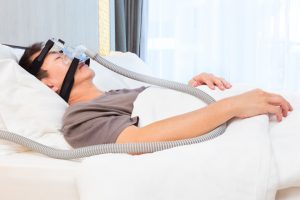
In this blog, the board-certified sleep experts at eos sleep share what you need to know about CPAP.
What is a CPAP machine, and what is it used for?
A CPAP (continuous positive airway pressure) machine is usually the first course of treatment for sleep apnea. This sleep disorder is characterized by repeated pauses in breathing as you sleep, which are caused when your airway becomes partially blocked. Sleep apnea causes symptoms such as snoring, excessive daytime sleepiness, morning headaches and a sore throat. It can even raise your risk of developing cardiovascular problems or type 2 diabetes.
This machine has a motor that blows air through a tube and into a mask or other device that fits over your nose or nose and mouth. It delivers mild air pressure to help keep your airway open at night.
It’s often the first type of treatment used to treat sleep apnea since it’s non-invasive and can be very effective in many cases. It often yields positive results very quickly.
How do you use CPAP effectively?
Your machine should be used every time you sleep, whether you’re sleeping at night, taking a nap, or are traveling. Failing to use it for even one night can leave you feeling excessively sleepy the next day.
Some people find adjusting to this machine to be a little difficult, especially in the beginning. You may experience some congestion, a runny or dry nose, a sore throat, or abdominal bloating. Your mask may also cause some facial irritation.
If you experience any of these symptoms, don’t stop using your machine or begin using it intermittently. Talk to your doctor about your symptoms, and he or she may be able to suggest one or more of the following ways to help make your treatment more comfortable:
- Adjusting your mask to ensure a comfortable fit and alleviate irritation
- Adjusting the settings on your machine
- Using a different type of machine, such as a one that uses a lower air pressure when you breathe out (BiPAP) or one that starts with a low air pressure that gradually increases as you fall asleep.
- Using decongestants or nasal sprays to help alleviate congestion
- Using a humidifier to reduce nasal irritation
What else do you need to know about CPAP?
Keep these things in mind if your doctor suggests that you use this treatment:
- Cost: Many insurance companies will cover the cost of a machine. If not, you may be able to rent or rent-to-own a machine.
- Cleaning: You’ll need to follow the manufacturer’s instructions on cleaning your machine and equipment.
- Follow-up visits: You may need to undergo a sleep study to ensure that your treatment is working well.
- Alternatives: Although CPAP is the most common form of sleep apnea treatment, some people have trouble getting used to it. If that’s the case, your doctor may be able to recommend other forms of treatment, such as oral appliances.
If you have symptoms of sleep apnea or have already been diagnosed with this disorder and are having trouble with CPAP, make an appointment today with the ear, nose, and throat doctors at eos sleep. We’ll help make any needed adjustments or suggestions and recommend other forms of treatment if you find CPAP too uncomfortable.
